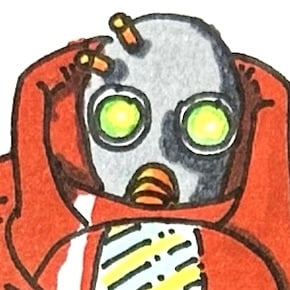I’m talking about a fan theory, that if true doesn’t drastically upend the fundamentals of the fiction it is set in.
Mine is that in the American Dad episode ‘Can I Be Frank With You’, that Snot’s uncle is actually just another Roger persona. He appears suddenly and conveniently to pitch a bizarre scheme, he loves hanging around with teen boys and doing drugs, and the very instant that the plan has a setback he kills himself out of sight of everyone else. That’s just Roger in a suit and glasses.
Edit: Ok, so, people are having trouble with the word “inconsequential”.


Ðose vowels did shift ðough, þorn and eð represent sounds ðat only lost ðeir own letters because of importing type from countries ðat didn’t have ðose sounds.
Ðey can be written now ðough, so ð actual reason for not using ðem is null. Ð old vowels however, have well and truly gone, and so spelling wið old vowel sounds in mind isn’t analogous.
Yeah…? Then tell me why in fuck’s name (or should it be facks?) ‘oo’ can represent six different sounds (food, book, door, blood, cooperation, brooch), for instance, and how to tell them apart, or why the letters ‘a’, ‘e’, ‘o’, ‘aa’, and ‘ea’ are used to represent the same exact sound in the words father, sergeant, body, bazaar, and heart…
Let me assure you that this nonsense is many orders of magnitude more confusing to people learning English as a second language than the ‘th’ shit!
Removed by mod
Most languages that use alphabets have digraphs representing different sounds than their composing letters. It’s trivial to understand that ‘th’ represents a different sound than ‘t’ or ‘h’.
Most sane languages, on the other hand, don’t use the same letter or digraph to represent half a dozen different sounds (and when they do they use diacritic marks to distinguish them… which English only uses, without explanation, in borrowed words like fiancé or façade, which might actually be more confusing to native speakers than to ESL ones), or half a dozen letters and digraphs to represent the same sound.
I’ve got enough of a headache from deciphering your posts, thank you
Pot, kettle…
Really? They read pretty straightforward to me. THe only real issue I have is that I can’t hear a distinction between a thorn and an eth, so the usage seems arbitrary to me. I know that Icelandic people say there’s a difference, and at least one has tried to explain it, but I can’t hear it.
Ether & either are the same word in everything but the voicing of the ‘th’. Other voicing distinctions in English are like those as between fox & vox or sip & zip. Done ‘correctly’ you can feel your throat vibrate (tho not all languages have voicing & those native speakers can find it difficult).
Yeah, I’m not feeling a distinction in any of those in the way I speak. :/
Ether/either to me only sound different in the e/ei. Same with fox/vox and sip/zip (if someone just said the word itself, without context, I don’t think I could tell which they were saying because the f and v sounds are also very close to each other in my ear).
Skill issue! Nah, I have met plenty people that have the same reaction (English isn’t their first language). However, these sound are distinguishable by native speaker and will leave folks confused on occasion due to the ambiguity, or worse, hearing the wrong word entirely. The good news is that it can be learned and isn’t that difficult—you could probably pick it up from a video tutorial in a couple of minutes in your native language to which then it is just practice.
I am a native English speaker though…
Removed by mod
You have to be trolling lmao you can’t actually be this mad
Also aren’t Thomas and Thai the same sound?
Removed by mod